Selecting the Ideal Pet Bird: A Comprehensive Guide
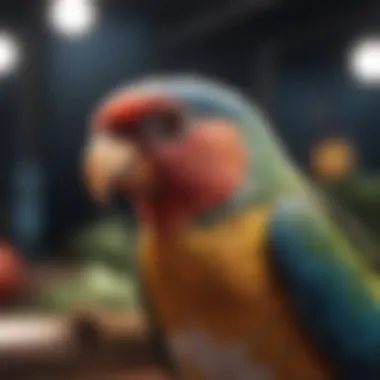
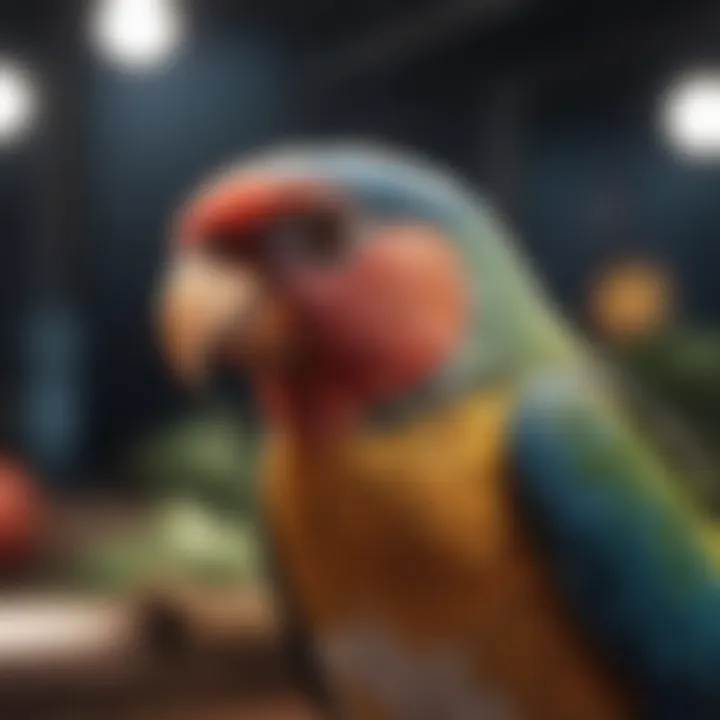
Intro
Selecting a pet bird is an endeavor that involves both passion and responsibility. For anyone considering avian companionship, it is vital to assess various factors that will ensure the harmony and well-being of the bird in your environment. Birds come with their species-specific traits, unique dietary needs, and interactive requirements. Understanding these can define how well a bird integrates into your home and life.
When selecting a pet bird, comprehension of individual species characteristics is as crucial as recognizing your lifestyle and preferences. This guide addresses significant areas, including care routines, behavioral patterns, nutrition, health considerations, and enrichment activities. Potential bird owners will find that informed choices in these areas ultimately contribute to a gratifying and lasting relationship that nurtures both birds and their humans.
Care Tips
Daily Care Routines
Maintaining a consistent daily care routine is essential for any pet bird's health and well-being. Establish a schedule that includes feeding, social interaction, playtime, and maintenance of their space. Depending on the species, birds may require different types of enrichment and care. For instance, larger birds often need more time outside of their cages to socialize, while smaller birds might be content with shorter sessions.
Cage Setup and Maintenance
Caging choices can greatly impact a bird's day-to-day happiness. Choose a spacious cage designed appropriately for the size of your bird. Use bird-safe materials to enhance both safety and comfort. With regular cage maintenance, such as repositioning perches, changing papers, and refreshing-related toys, you promote a healthy environment. This routine not only ensures cleanliness but also keeps the bird mentally stimulated.
Hygiene and Cleaning Practices
Maintain hygiene scrupulously by cleaning the cage regularly. A dirty habitat breeds illness and stress. Daily removal of droppings and leftover food with a deep cleaning conducted weekly can be effective. Essential cleaning materials should be bird-safe, ensuring the environment remains harmonious.
Seasonal Care Adjustments
It is also important to adjust care based on the seasons. For instance, during winter, ensure that your bird is protected from drafts and extreme temperatures. Summer months might require the introduction of shaded areas for outdoor explorations. Adaptation in care and habitat allows birds to feel more comfortable throughout seasonal changes.
Behavioral Insights
Understanding Bird Body Language
Birds communicate largely through body language. Learning to interpret signs like body posturing, wing flapping, or head tilting can enhance bonding experiences significantly. A relaxed bird is generally one with smooth feathers and a slightly raised head.
Common Behavioral Issues and Solutions
Understanding potential behavioral issues such as excessive screaming or biting is imperative. Each behavior likely heralds a deeper need or emotion. Address issues sternly but kindly, offering alternative commitments such as toys for distraction.
Positive Reinforcement Techniques
Utilizing positive reinforcement is a fundamental approach when training birds. Simply allocate rewards for desired behaviors—often treats work effectively. This establishes trust and encourages the bird to comply and engage.
Social Interaction Needs
Birds are inherently social creatures. Social needs must be met daily to maintain psychological health. Allocate time for interaction either with you or with other birds if possible. Neglecting social needs can result in anxiety and destructive behaviors.
Nutrition Guides
Essential Diet Components
Feeding birds a well-rounded diet is integral to their daily care. A proper blend of seeds, nuts, fruits, and vegetables, tailored to your specific bird's requirements is paramount. Each species has its own set of nutritional needs. Research your bird's ideal diet plan thoroughly.
Safe and Toxic Foods
Not all foods appropriate for humans are safe for birds. For instance, avocados, chocolate, and caffeine are toxic. Conversely, safe treats include apple slices and carrots. Always verify food one is offering to ensure you select healthy options.
Supplements and Treats
While a balanced diet is fundamental, certain situations may require supplementation. Depending on specific dietary needs, consult with a veterinarian for advice on adding vitamins or minerals. Occasional treats can help keep your pet motivated during training.
Feeding Strategies for Different Species
Diverse species necessitate various feeding approaches. Large parrots, for example, often do well with a stronger focus on pellets and high-quality seed, whereas small budgies may snack more effectively on fruits. Understanding these nuances can refine feeding strategies.
Wellness and Health
Routine Health Checkups
Routine veterinary checkups cannot be ignored in felting a symbiotic relationship with your bird. Creating a connection with an avian vet can safeguard against health complications and serve as a balance to prompt action when needed.
Identifying Symptoms of Illness
Vigilance is crucial when it comes to recognizing symptoms of potential illness. Watch out for variations in eating habits, lethargy, or changes in droppings as signs to consult a vet. Early detection significantly increases treatment effectiveness.
Preventative Care and Vaccinations
Preventative care plays a strong role in general well-being. Investigate appropriate vaccination schedules and receive routine blood tests recommended for your specific type of bird to ensure immediate protection against common diseases.
Mental and Emotional Well-being
Lastly, consider the mental and emotional state of the bird. Engage them often through conversation, attention, and companionship. Banish boredom and isolation to promote happiness, as both can threaten behavioral or emotional stability.
Enriching Activities
Toys and Playtime Ideas
Toys are not merely playthings. They serve developmental purposes and reduce stress. Rotate toys regularly to sustain engagement. Many birds love challenges; provide puzzles, ropes, and bells to spark regular interest and play.

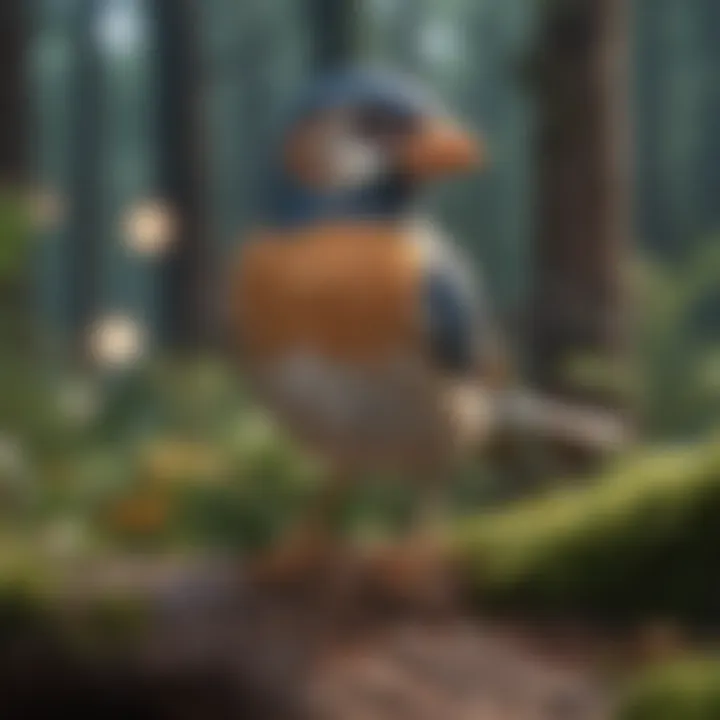
Training and Tricks
Training is vital, foster positive engagement. You might choose simple tasks like teaching your bird to come, or other fun behaviors. Start with short sessions to maintain focus, giving clear commands along with positive rewards. This structure can improve the bond while introducing good habits.
Outdoor Activities and Interaction
Providing outdoor time allows birds to experience new sights and sounds. Use safe harnesses to explore securely. Supervise them idealistically, noting their reactions to new flora and fauna—this can immensely enrich their life and yours.
DIY Projects for Mental Stimulation
Consider creating DIY enrichment challenges. Build simple activities or puzzles to entice problem-solving. Even using household items safely can provide endless hours of entertainment for a bird. Better yet, the cost is minimal.
Understanding Pet Bird Ownership
Understanding the landscape of pet bird ownership is crucial. It encompasses a range of factors, from the responsibilities involved to the joys they can bring into a household. Potential bird owners must consider their lifestyle, space availability, and if they can provide the necessary commitments. Owning a pet bird may appear simple at first glance. However, it involves careful thought, empathy, and sincere commitment. Therefore, it is pivotal to delve into the commitment involved as well as the benefits of housing these feathered companions.
The Commitment Involved
Committing to pet bird ownership requires a universal acknowledgement of responsibility. Birds, like any pet, demand consistent attention and care. Setting aside daily time for interactions, cleaning their habitat, and feeding becomes essential. This regular effort leads to a critical understanding of your selected bird's needs.
- Time Commitment: Birds thrive on companionship. Free time for bonding can lead to lasting relationships between owner and bird.
- Financial Responsibility: Owning a bird includes financial obligations—from purchasing a suitable cage to avian diets and veterinary appointments.
- Life Expectancy Consideration: Pet birds can have long lifespans; larger species may live even longer than many cats or dogs. Owners must ideate their plans around this significant time frame.
Furthermore, maintenance demands attention too. Cleaning their habitat should never be underestimated. Trying to accommodate these will surely contribute to a satisfying bird-keeping experience.
This competence in care addresses their needs and raises questions regarding long-term commitments. Noting the potential for situational shifts over the years—career moves, family changes, even lifestyle adaptations. Additionally, over time, proper bonding definitions escalate; developing trust may take dedication.
Benefits of Pet Birds
Pet birds offer unique benefits that resonate deeply beyond simple companionship. Utilizing features customarily found in larger animals while retaining enchanting simplicity makes these flying pets ideal for numerous households.
- Companionship and Social Interaction: Birds often develop attached easing loneliness. Watching them retains joy, assuring consistent behaviors supply interaction. Social birds, like African Grey parrots, thrive on mimicking and engaging subtly with their human companions.
- Mental Stimulation: Owners also gain factors helpful for mental engagements while keeping watch over their dynamic behaviors. Birds exhibit searching patterns, adaptation skills, and replicative versions of entertainment, engaging the observer.
- Space-Efficient Living: Small species, like canaries or parakeets, occupy minimal space compared to dogs and cats. Their environments can fit within smaller areas without compromising growth. That works to urban lifestyles where space constraints perseveres.
- A Teaching Platform for Children: These creatures can help children understand responsibility early in structured caregiving environments. Ultimately, valuable lessons stem effortlessly from interactions.
As descibed, the commitment to bird ownership supports a try individuality; still, prior and fair factors outline benefits during the process as well. The decision touches levels of personal growth encompassing varied experiences. As potential can identify these merits, they lead closer to informed final decisions—as bird owners' awareness possibly flourishes enriching companionship.
Reflective Point: Grasping the commitment and benefits extensively can solidify your thinking process towards finding the right feathered companion.
Evaluating Your Lifestyle
Choosing a pet bird needs a thorough evaluation of your lifestyle. This process is necessary to guarantee that both you and your future bird will enrich each other's lives. Lifestyle considerations can really shape your compatibility with different bird species. This improves satisfaction and lowers frustrations that arise during pet ownership. Several critical elements underlie these considerations: time availability, space needs, and economic factors.
Time Availability for Care
Caring for a pet bird requires consistent time commitment. Birds thrive on routine and interaction. Daily tasks, like feeding, cleaning, and socialization, contribute to a bird’s well-being.
- Feeding: Birds need fresh food and water daily. Also, quality time spent observing their eating habits can clue you into their health.
- Cleaning: Maintaining hygiene is crucial. Cages should be cleaned regularly to prevent disease.
- Social Interaction: Many bird species, such as budgerigars and lovebirds, require time outside their cage and mental stimulation through play.
Understanding your daily availability for these tasks will influence which bird species you can responsibly own. If your schedule is packed, consider smaller, independent birds like finches or canaries.
Space Considerations
Space is another vital factor in bird ownership that deserves thoughtful consideration. Each bird species demands specific habitat conditions.
- Cage Size: Larger birds require bigger cages. For example, macaws need substantial space to fly and exercise.
- Safe Zones: You must ensure safe zones in your home. Birds will want to explore outside their cage.
- Noise Levels: Larger birds tend to be louder. Your home’s layout and your tolerance for sound will impact your choice of pet. Small urban apartments are likely better suited for quieter species.
Analyzing your available space shows not only what might work but provides ideas for enriching your bird's life through environmental variations.
Economic Factors
Finally, consider the economic aspects of bird ownership. Keeping birds might involve ongoing costs other than just the initial purchase price.
- Initial Costs: Purchasing a pet bird is just the “tip of the iceberg.” Potential owners must factor in the cost of sturdy cages, toys, and initial setup.
- Ongoing Expenses: Food, vet care, and general supplies need ongoing financial commitment. For example, high-quality bird food is often essential for nutritional health.
- Unexpected Costs: Illness or accidents can increase your financial burden significantly.
Setting a budget for your expenses provides a clear picture. This can guide your selection process effectively. Ultimately, comparing your budget against the care requirements keeps the experience rewarding and sustainable.
By carefully evaluating your lifestyle, you can make an informed decision about whether a bird fits your household dynamics and commitment levels effectively.
Popular Pet Bird Species
Understanding the various species of pet birds is critical for any potential bird owner. Each species comes with its unique traits, dietary needs, and social behaviors. Knowing what makes each type distinct can greatly influence your decision on which bird might be the best fit for your lifestyle. Among the benefits of choosing the right species is the improved wellbeing of both bird and owner. It is not just about picking a pet, but also about forming a relationship that satisfies both parties. Let’s explore the popular species of pet birds that many choose to welcome into their homes.
Small Birds
Budgerigar
Budgerigars, often called budgies, are a favored choice among bird enthusiasts. Their vibrant colors and vocal talents make them appealing pets. A significant aspect of budgerigars is their sociable nature. They tend to bond well with humans and can learn to mimic phrases if provided with regular interaction. Another unique feature that contributes to their popularity is their size. Budgies require less space compared to larger birds, making them ideal for apartment living. However, they do need flying space; appropriate cage dimensions are essential. In summary, budgerigars are engaged, delightful companions with a manageable size, but potential owners should be ready to spend time interacting with them.
Canary
Canaries stand out for their singing abilities, especially the males. They are often chosen for their beauty and melodies, providing pleasing sounds in the home. A notable characteristic of canaries is that they can thrive both inside a cage or a flight aviary setup. This flexibility allows owners to decide on habitat based on available space. Canaries can have different vibrant colors, educating potential owners about genetic variations in birds. While they are generally easy to care for, without social interaction like other birds tend to enjoy, they might become shy. Thus, understanding their need for social environment can enhance their singing and overall behavior.
Finch
Finches are known for their lively behavior and cohesive groups. They usually do well in pairs or small flocks which aid in promoting their social nature. A key characteristic of finches is their diverse aesthetic appeal, coming in various colors and patterns, enriching the home visually. Another significant aspect is their delightful chirping, which many owners find comforting. However, finches can be less interactive than budgies or canaries. Their care often involves regular feeding and appropriate environmental conditions. Although less cuddly, they provide visual charm and pleasant sounds to over all ambiance of the space.
Medium Birds

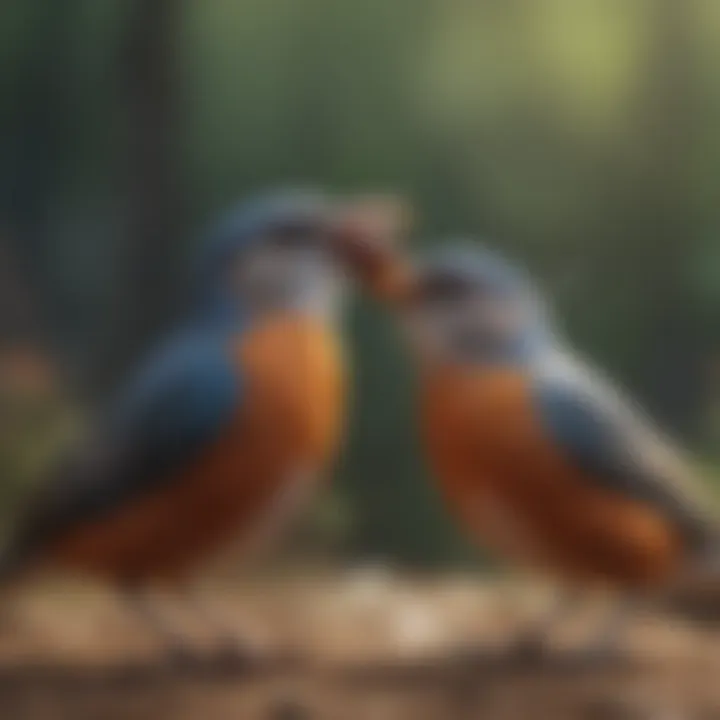
Lovebird
Lovebirds are small yet remarkable in their affectionate nature, making them an incredible choice for potential owners. Their strong pair bonding showcases the capacity for companionship in birds. These pups come in various colors which add visual delight to the home. Often seen cuddled together, lovebirds exhibit a remarkable display of social behavior and attachment when blended with interaction. However, they do need consistent companionship to prevent loneliness. Hence, a single lovebird often requires significant attention from the owner routinely. While they can sometimes be nippy, their loving disposition generally prevails when properly cared for.
Quaker Parrot
Quaker Parrots, also known as Monk Parakeets, draw a good amount of attention due to their vocal imitations and social nature. Their playful personality enhances their immediate appeal among pet owners. Notably, Quakers have a remarkable ability to speak clearly, which is often surprising for those unfamiliar with their capabilities. However, their inquisitive nature also means they tend to require attention and enrichment to stay engaged. A potential challenge is their loud vocalizations, which can be a downside in quieter homes. Overall, their engaging nature and ability to interact make them popular yet they require proper management to ensure harmony.
African Grey Parrot
The African Grey Parrot is well-regarded among bird analysts due to cognitive abilities. Their excellent vocal skills and intelligence are worthy of admiration. These parrots need an enriching environment to engage their minds adequately. Owning an African Grey involves commitment to social interaction and activities to maintain mental health. These birds require an engaging experience with physical stimulation. However, they can tend to bond strongly with one person, developing a preference that makes them a devoted companion. Their talking ability is impressive. Despite these benefits, their demanding atmospheres make them less ideal for beginners.
Large Birds
Amazon Parrot
Amazon Parrots are celebrated for their stable temperament and friendliness. Their playfulness adds joy and entertainment to a household. Many pet owners are impressed with their extraordinary vocal loudness which often rivals that of smaller birds. Buying an Amazon might be suitable for active individuals who enjoy engaging pets. Their colorful plumage can be a stunning addition to their habitats. However, they demand a deeper commitment to training sessions and care; despite their generally friendly demeanor, neglect can lead to behavioral challenges. For those up to the task, I think an Amazon Parrot can be a delightful companion.
Cockatoo
The Cockatoo is one of the most affectionate birds, known for their strong instinct of companionship. Their intense attachment to their owners illustrates their loving nature. Cockatoos boast striking physical appearances but there can be undesirable downsides too, such as their need for engagement and high vocal volume. Regular interaction with this creature ensures them remaining content. They can surprise with unique personalities. However, they do require proper training to manage their potential for loud noises and unresolved boredom. For an interactive lifestyle, you will find them exceptionally gratifying, defining their strong-acquired bond.
Macaw
Macaws tend to be striking with vivid feathers and extravagant personalities. The significant aspect contributing to their preference can often be credited for being socially advanced. Bonding must involve regular attending, meaning those with steadfast commitment will find it immensely satisfying. However, due to their size, macaws require ample space and specialized diets in proper setups compared to other smaller species. Maintenance can require higher economical and committed financial aspects. Without doubt, this species enchants many due to their vivid colors and lively disposition, albeit requiring dedicated time captured thorough trainings and interaction.
Assessing Each Species' Characteristics
Understanding the characteristics of each bird species is crucial in the process of selecting a pet bird. These traits not only reflect the individual behaviors and needs of different birds, but they also play a vital role in how well they will fit into your particular lifestyle. By analyzing their social behaviors, vocalization patterns, and lifespan expectations, potential owners can make informed decisions that will contribute to a satisfying and harmonious relationship. As birds are intelligent creatures, recognizing the nature of the species you choose will directly affect their care and your interactions with them.
Social Behavior
Social behavior is one of the defining aspects of pet birds. Various species exhibit differing levels of social interaction, which significantly influences their suitability as pets. Some, like African Grey Parrots, are very social and can bond deeply with their owners. Others, such as some finches, are more independent and prefer a larger group to feel comfortable.
When considering social behaviors, potential bird owners should reflect on how much time they are willing to devote to interaction and companionship. Many pet birds thrive on social engagement for their wellbeing, while others may be more passive. It is beneficial to know your preferences to ensure that your chosen bird's needs are matched well with your lifestyle.
Vocalization Patterns
Vocalization is another important characteristic to assess. Different species have distinct vocalizations ranging from chirps and whistles to loud squawks. Some, like Parakeets, can learn to mimic sounds and even human speech, which can be entertaining. In contrast, other species may be silent or have subtle calls that may not generate as much interaction.
Understanding vocalization patterns helps in choosing a species that suits your environment. For instance, if you live in an apartment or prefer peace and quiet, you may lean towards smaller, quieter birds, whereas if you enjoy an active and noisy companionship, larger birds might be ideal. Birds with complex vocalizations can also display higher intelligence and engagement, influencing the overall dynamic of pet ownership.
Lifespan Expectations
The lifespan of different bird species merits attention during the selection process. Lifespan varies significantly, ranging from a short lifespan of around five years for small birds such as canaries, to medium birds like cockatiels, which can live up to 20 years, or larger breeds like macaws, which may live for over 50 years.
Understanding the anticipated lifespan equips a potential owner with the foresight to commit to long-term care. With longer lifespans come meet specific needs, handling expectations, and even eventual planning for care of older birds. A long-term relationship with your pet bird can impact various aspects of family life.
Ultimately, careful examination of these species characteristics – social behaviors, vocal patterns, and lifespan – is paramount for those considering the addition of a pet bird to their home.
Understanding Nutrition and Health Needs
Understanding the nutrition and health needs of pet birds is crucial for their well-being and longevity. Nutrition plays a significant role in their overall health, helping to prevent diseases and ensuring that they thrive in a home environment. Bird owners must recognize that inadequate diets can result in health issues, making it vital to educate themselves on the proper dietary guidelines, signs of illnesses, and the necessary preventative care. Addressing these areas lays the foundation for a healthy bird, which in turn leads to a rewarding pet ownership experience.
Basic Dietary Requirements
Each bird species has specific dietary needs, which can influence their physical condition and behavior. Generally, a pet bird requires a diet that includes a mixture of seeds, pellets, fresh fruits, and vegetables. Consider the following key dietary elements:
- Seeds: While seeds are often beloved by birds, they should dominate the diet.
- Pellets: These provide essential nutrients that seeds alone may lack. Look for high-quality pellets that suit your bird's species.
- Fresh Produce: Offer a variety of options such as leafy greens, carrots, and berries. These foods contain vital vitamins and minerals.
- Protein Sources: Species like cockatiels or parrots may benefit from occasional sources of protein such as boiled eggs or legumes.
It is crucial to avoid toxic foods such as avocado, chocolate, and caffeine. Therefore, being aware of dietary restrictions can not only extend the bird's life but also improve the overall quality of life for your pet.
Signs of Illness
Birds are proficient at hiding their illnesses, often making it difficult to detect health problems early. Bright eyes, active behaviors, and a clean-feathered appearance usually indicate well-being. You should monitor these signs
- Change in Vocalization: An active bird that stops chirping may alert you to an illness.
- Loss of Appetite: An early indicator of discomfort is when a bird refuses favorite foods.
- Abnormal Droppings: Consistency, color, and odor can indicate various health problems.
Keep an eye on hesitant behaviors, as they can be caused by stress or significant health concerns. Regular check-ups with veterinarians experienced with birds are advisable to catch any issues before they escalate.
Preventative Care
Preventative care involves taking actions to promote your bird’s health before problems arise. Simple yet effective strategies include:
- Regular Vet Visits: Schedule yearly check-ups, ensuring that vaccinations and health assessments are consistently managed.
- Proper Hygiene: Maintain clean living conditions for your bird to decrease the risk of bacterial growth and infections.
- Balanced Diets: Already discussed above, but emphasize regularly changing the food option ensures they’re not simply eating one kind part. This adds variety to their nutritional intake.
- Social Interaction: Birds are social creatures and need daily interaction to ward off stress and related illnesses.
Integrating these practices into your routine can enhance the bird's health practices while allowing owners a comprehensive view of their responsibility in their pet's long-term care.
A balanced diet is the cornerstone of any bird's health. Consistency in providing appropriate foods combined with ongoing monitoring ensures a long and happy relationship between you and your pet bird.
Creating an Enriching Environment
Creating an enriching environment is a crucial factor in ensuring the well-being of pet birds. Birds thrive in settings that mimics their natural habitat. An appropriate environment helps to reduce stress and boosts overall health. It enables birds to exhibit natural behaviors while making them feel secure. Thus, understanding how to cultivate this enriching environment is vital for their happiness.
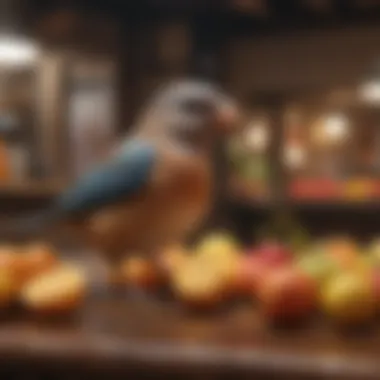
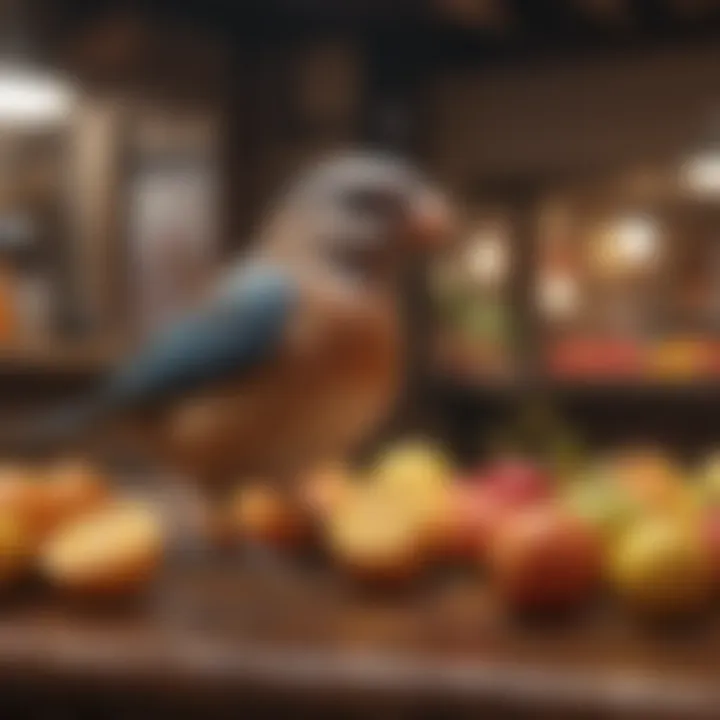
Habitat Design
A well-designed habitat is more than just a cage; it is the heart of a bird’s home. Good habitat design caters to the need for physical and mental activity. It should comprise adequate space, placement of perches, levels for climbing, and materials to chew.
Perches should vary in size and shape to encourage exercise. This allows birds to strengthen their feet and claws. Birds enjoy different surfaces, such as wood, which provides a natural feel. Be sure to place perches at various heights to create an engaging substrate for flapping and climbing activities.
Enrichment items should also be included such as branches, ropes, and swings. These facilitate play and exploration. It is important to select nontoxic materials, which will help prevent potential health risks. Birdcages can often be enhanced by adding appropriate plants, providing a more natural feeling habitat.
Aside from options in the cage, larger, improvisational spaces for flight are also beneficial. Letting birds out to fly in a safe area cultivates physical coordination and helps foster their social behaviors. Bird-proofing rooms ensures safety during supervised flight time.
Overall, provide areas where birds can feel secure yet stimulated. Regular rearrangement of the setting can also maintain interest, all while ensuring optimal comfort levels.
Toys and Activities for Stimulation
Birds require mental stimulation just as much as they do physical. Engaging activities and toys preserve their cognitive abilities. They keep them active and can help mitigate issues such as boredom, leading to unhealthy behaviors.
When selecting toys, focus on maze types, chew toys, and puzzles. These encourage playful interaction. Chewing toys fulfill natural instincts, aiding in beak maintenance.
Consider rotating toys regularly. This not only keeps their environment fresh but also upholds their curiosity. Interactive toys can also play an important role. Such toys might challenge birds to solve simple problems or complete tasks to dispense treats. This rewards them and fosters intelligent interaction with their environment.
It’s beneficial to monitor playtime and variety in activities. Every pet bird will react differently. Rely upon your observations to determine which types of stimulation resonate well with each bird's personality.
With care in creating a habitat that satisfies physiological needs and accoring to activities that engage the mind, bird owners can help their avian companions lead fulfilling lives.
Long-Term Care and Management
Long-term care and management are crucial aspects of pet bird ownership. Underestimating the need for continuous attention can lead to significant challenges. Keeping a pet bird is a commitment that extends far beyond the initial excitement of bringing a new feathered friend home.
A primary consideration involves daily responsibilities. Establishing a routine helps not only meet the physical needs of the bird but also nurtures the bond between the bird and the owner. Responsibility encompasses feeding, cleaning, and providing adequate mental stimulation. Ensuring that your bird receives a balanced diet is essential for maintaining its health. Birds are susceptible to various health issues without proper nutrition.
Moreover, a clean living environment is vital. Regularly cleaning the cage and changing the bedding prevents the buildup of bacteria and parasites that can affect aven health. These tasks contribute to a bird’s well-being, setting the stage for a healthy lifecycle.
Effective management promotes a sense of security and stability for both the bird and the owner, enhancing the quality of life for both parties involved.
Behavioral training also plays a significant role in long-term care. It not only helps in establishing a harmonious living environment but also contributes to the bird's mental health. Birds need stimulation and challenges to remain healthy and happy. A well-trained bird tends to exhibit fewer behavioral problems. Training can include teaching basic commands, tricks, and social interaction. This process fosters trust and communication between the pet and owner.
In summary, long-term care and management require daily routines and ongoing training assessments to ensure a pet bird thrives. Understanding the seriousness of these responsibilities will lead to a rewarding experience for both the owner and the bird.
Integrating a Bird into Family Dynamics
Bringing a bird into a home involves more than simply choosing the right species; it means weaving a new member into the fabric of family life. This integration can enrich the daily experiences of both the bird and the family. Understanding the nuances surrounding this aspect is crucial for fostering a harmonious atmosphere. Successful integration enhances not only the happiness of the bird but also the well-being of all family members involved.
Introducing the Bird to the Home
When introducing a bird to the household, gradual steps play a vital role. First, designate a calm and quiet area for the new feathered companion. This safe space will alleviate stress and provide the bird a chance to acclimate to its surroundings before it interacts with family members. Ensure that the bird's cage is placed in a communal area, allowing it to observe the goings-on in the household without being too overwhelmed.
Be mindful of creating a peaceful atmosphere during the initial introduction. You could have family members come and sit quietly near the cage, avoiding sudden movements or loud sounds. This approach helps in building trust.
Visitors should be informed of the bird's arrival. It's essential they respect its space and understand the importance of allowing the bird to adjust at its own pace. Over time, with gentle encouragement and treats, family members can gradually engage them and create a stronger bond.
Interaction with Children and Other Pets
Involving children in the process can create special connections, but supervision is paramount. Teach them to be gentle and respectful in their interactions with the bird. Additionally, it’s important to highlight that children should approach the bird while seated or on lower ground. This reduces intimidation and allows the bird to feel safe.
For families with other pets, the introduction may require more cautious consideration. Birds might see dogs or cats as potential threats. Keep initial interactions monitored and separate them at first. Several strategies may help during this integration:
- Supervised Introductions: Allow short, controlled visits where users can observe without direct contact.
- Familiarization: Encourage curiosity by allowing the other pets to smell or lightly engage with objects the bird has interacted with, helping bridge familiarity.
- Safe Spaces: Ensure the bird has safe havens where it can retreat in case it feels too stress.
In summary, making a bird feel part of the family calls for deliberate planning, education, and gradual introduction. Such an approach paves the way for rewarding relationships, fostering mutual respect and understanding within the household.
"Successful integration of a pet bird is not a spontaneous affair but a planned process that demands patience and hovering concern for the creature's well-being."
Links for additional reading:
Concluding Thoughts on Choosing a Pet Bird
Choosing a pet bird is not merely about selecting a species that looks appealing. It is about understanding the ongoing responsibilities and the commitment required to ensure a happy and healthy life for both the bird and the owner. This concludng section synthesizes the essential elements discussed in this guide and emphasizes the importance of sound decision-making in this journey.
Bird ownership demands more than just novelty; it necessitates a blend of preparation, awareness, and an appreciation for the characteristics of various species. Enthusiasts must consider lifestyle compatibility and environmental factors before taking this leap. By adeptly evaluating one's circumstances against the bird’s needs, owners foster a harmonious relationship.
"Taking time to reflect on one's decision significantly enhances the experience of bird keeping."
Beyond mere interest, this reflection can enable prospective owners to fully immerse themselves in understanding those subtle dynamics essential to bird care, thus benefiting both pet and owner.
Reflecting on Your Decision
As you approach the conclusion of your search for the right pet bird, reflecting on the decision is crucial. Think carefully about your reasons for wanting a bird, and assess if your lifestyle can accommodate its needs. Important aspects to reminisce about include:
- Interest in Species Behavior: Recognizing your preferred species’ general behavior and compatibility with your home environment is key. Each bird species varies significantly in its social habits, sound levels, and companionship needs.
- Commitments Required: Institute a checklist of daily, weekly, and monthly commitments for care. Asking questions such as how often your future bird will require training, social interaction, or dietary changes can help ensure readiness before adoption.
- Economic Viability: Consider key budgets, not just for initial purchase but long-term sustenance—food, habitat, toys, vet visits. Preparation is intelligence beyond impulse decisions.
By adopting an analytical thinking approach to reflecting can lead to well-informed choices, helping maintain satisfaction over years.
Resources for Continued Learning
Learning does not cease after selecting your ideal pet bird; it is an ongoing process. Utilize reputable resources to stay informed, helping deepen your understanding and upkeep standards. Useful references include:
- Wikipedia - Comprehensive information on various bird types and behavior characteristics Wikipedia Bird Life
- Britannica - In-depth articles that can enrich your pet’s care approach Britannica on Pet Birds
- Reddit - Join community discussions, gain ideas, and exchange experiences with other bird owners Reddit Bird Owners
- Facebook Groups - Join specialized bird owner groups where you can connect, and network, and ask questins from a community of enthusiasts.
These resources empower prospective and current bird parents alike towards achieving positive outcomes.















